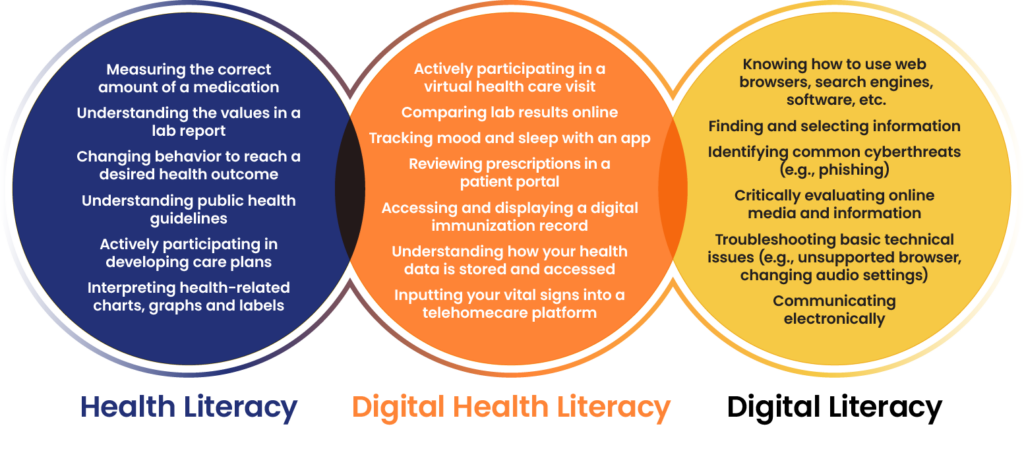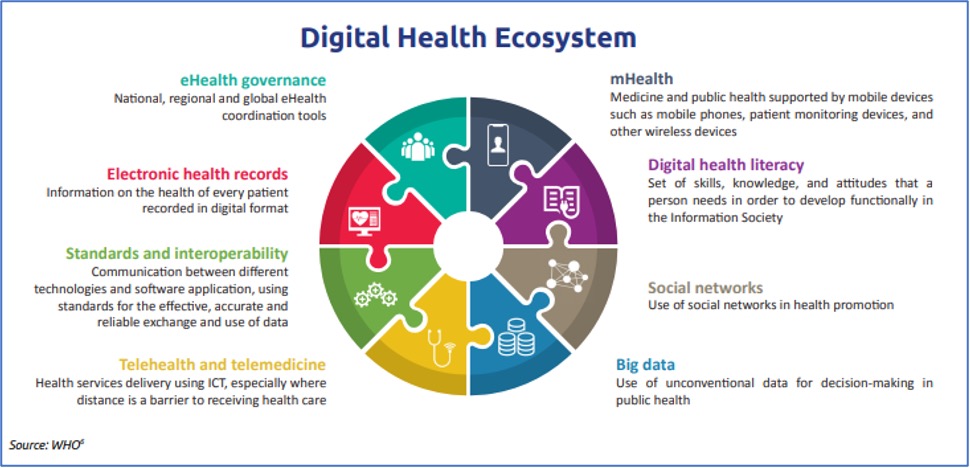In this section, we will cover:
Why digital health literacy is important to individual engagement
How the availability of technology affects digital health literacy
How GDHP members educate individuals and increase digital health literacy
How GDHP members overcome barriers to digital health literacy
How GDHP members make digital health easier to understand and use
What is Digital Health Literacy?
Digital Health Europe defines digital health literacy as “the ability to seek, find, understand and appraise health-related information from electronic resources and apply the knowledge gained to making appropriate health decisions in order to address or solve a health problem.” (30) Examples of digital health literacy include accessing your electronic health record, communicating electronically with your health care team, discerning reliable online health information, and using health and wellness apps. Digital skills alone do not enable individuals to engage with digital health services or digital content. Individuals also need health literacy skills to find, assess, and use the digital health resource. The WHO proposes the policy to put “people at the centre of digital health through the appropriate health data ownership, adoption and use of digital health technologies and development of appropriate literacy; the focus will cover not only patients, families and communities but also health workers.” (31)
Individuals typically benefit more from digital health tools as their digital health literacy skills advance. This may allow individuals to have better health. According to EuroHealthNet “People who are digitally health literate – those that can gain and use knowledge from electronic sources to solve a health problem – are more able to manage personal health and care issues. Better prevention models can be developed, and healthy behaviours supported. However, there is a risk that the most vulnerable people are left behind in the transition.” (32)
GDHP recognizes the importance of advancing digital health literacy globally. The GDHP Clinical and Human Engagement Work Stream conducted a Digital Health Literacy Survey[1] (33) in 2022-2023 which illustrates digital health literacy as the intersection between health literacy and digital literacy as noted below. As demonstrated in the Venn Diagram below, health literacy and digital literacy have their benefits, but the most benefit comes to individuals who are proficient in digital health literacy.
[1] The Digital Health Literacy Survey analysis is in progress and not yet publicly available.

An example from Canada discusses their Digital Health Learning Program that provides free resources to help individuals learn about digital health care services.
Canada | From Around the Globe
Digital Health Learning Program
Canada Health Infoway developed the Digital Health Learning Program,a collection of free resources to help individuals learn about digital health care services available in Canada, especially virtual care and individual access to their data. Canada Health Infoway noted they have collaborated with “partners across Canada and have had input from more than 1,200 Canadians to develop resources aimed at helping you better understand what digital solutions are out there and how they might apply to you.” (34)
Digital Health Equity Analysis
Canada Health Infoway presented findings from their study Digital Health Equity Analysis: Access to Electronically-Enabled Health Services. The study analyzed equity before and during the COVID-19 pandemic and made observations such as:
- “During the pandemic, younger Canadians are using virtual care (video and email/text messaging) at a higher rate compared to adult men and women.
- Adult men and women show lower digital health literacy scores relative to the youth…
- Rural Canadians are accessing electronically enabled health services at a lower rate than urban Canadians.
Canadians in urban centers:
- High-income Canadians are more likely to access digital health compared to low-income Canadians.
- Canadians with higher digital health literacy scores are more likely to use digital health.” (35)
What Technology is Available to Individuals?
Individuals need access to digital technology including devices (such as mobile phones, electronic devices, and computers) and networks (such as the internet or cellular networks) to have the opportunity to engage in digital health literacy. Some GDHP members report that broadband availability is usually uneven and low in remote areas. Canada adds that those with income insecurity, housing insecurity, newcomers, and those with language or accessibility barriers, are less likely to access networks and digital devices. Similarly, New Zealand notes the cost of mobile data is a barrier that must be addressed to make digital health services affordable for its population.
New Zealand | From Around the Globe
Removing Barriers to Mobile Data
For some New Zealanders, the cost of mobile data can be a barrier to accessing essential health and wellbeing information and digital health services. Those who cannot access information and services often have the highest needs. Zero Data removes this barrier by providing free access to key health sector websites accessed through the www.zero.govt.nz website for anyone using certain mobile networks.
It is not enough for technology to be available to everyone because individuals need to understand how to use technology for their healthcare. For example, owning a smartphone does not help you if you do not understand how to use the features and apps on the device.
Similarly, digital health literacy is essential to individual engagement with digital health systems. In England, public libraries are working in partnership with National Health Service (NHS) knowledge and library services as part of a National Health and Digital Literacy Partnership led by NHS England with the Libraries Connected and Arts Council England (CILIP). These public libraries act as digital hubs in their local communities and are ideally placed to help the public access digital health content and develop their digital health literacy skills.
EuroHealthNet created the diagram below showing eight components of the digital health ecosystem individual to patient engagement noting “Digital health literacy and equity are closely linked. People lower along social gradients tend to have higher disease burdens and health needs, yet they are more vulnerable regarding access to and understanding of health information. They may be less aware of issues of privacy, health data use, and data protection and are also more likely to experience digital exclusion.” (32)

How are GDHP Members Overcoming Barriers to Digital Health Literacy?
GDHP members know there is work to be done to ensure all populations understand digital health literacy. Below are considerations for digital health literacy inclusion. It is important to understand the digital health literacy of different populations within your country. For example, is your portal accessible across populations? Have you evaluated the inclusiveness of the portal?
Sweden | From Around the Globe
Know Your Population and Their Preferences
Sweden bases its digital strategy on facts and insights about how individuals are using the internet. They have been analyzing trends since 2021. Chapter 2 of The Swedes and the Internet describes Swedes’ use of healthcare apps. For example, 80% of their population uses e-services for healthcare and the percentage is higher for people born in the 1970s or later compared to people born before 1950. (36)
Similarly, the Republic of Korea has a detailed annual Digital Information Gap Survey (not limited to health) which compares different populations to the general population in terms of accessibility, competency, and utilization of digital information.
Republic of Korea | From Around the Globe
Assessing the Digital Divide
According to the 2022 Digital Information Gap Survey, the average level of digital informatization among the public (aged 7 or older) is 67.7 points (accessibility 92.6, competency 65.3, utilization 57.5). For vulnerable groups (individuals who are differently abled, elderly, low-income, farmers/fishermen, and marriage immigrants), it is reported to be lower than the digital informatization level of the public. In this vulnerable group, the level of informatization of the elderly aged 65 or older is the lowest in the group in terms of accessibility (95.1% of the public), competency (54.5%), and utilization (72.6%). The survey contains graphics illustrating variations in digital usage and gaps among vulnerable groups. (37)
| Group | Overall % | Accessibility % | Competency % | Utilization % |
| Elderly | 69.9 | 95.1 | 54.5 | 72.6 |
| Differently Abled | 82.2 | 82.2 | 75.2 | 82.0 |
| Low-Income | 95.6 | 95.6 | 92.9 | 96.4 |
| Farmers/Fishermen | 78.9 | 78.9 | 95.7 | 78.8 |
The Republic of Korea acknowledges personal barriers such as interest and activeness are factors besides technical and institutional barriers in adoption of digital health literacy tools.
The United Kingdom uses a geodata tool to assist health organizations in addressing health inequity by using quantitative comparisons of local districts or boroughs to the national average.
United Kingdom | From Around the Globe
Target Interventions Based on Local Data
Developed by the University of Southampton and commissioned by NHS England, this geodata tool provides an estimate of the percentage of each local authority population with low health literacy or numeracy. Its aim is for health services to be a multi-channel offer which meets individual needs and helps to free up resources for those who need face-to-face care. (38)
Understanding your population’s past and present statuses of digital literacy, health literacy, and digital health literacy may allow you a basis to plan and measure your progress. When you recognize specifically how to improve, you could set goals. You could benchmark against other countries to evaluate your status as Italy does in the next story.
Italy | From Around the Globe
Starting from Behind and Making Remarkable Progress
In 2022, Italy was ranked 18 out of 27 EU nations in level of digitalization. 46% of Italy’s population had basic digital skills (54% average for the EU) and 40% of its internet users used public digital services (65% average for the EU). The situation is changing fast. Italy is advancing digital health literacy following the National Strategy for Digital Skills based on a plan adopted in December 2020. Italy identified 111 initiatives and set milestones and targets including equipping 70% of the population with basic digital skills by 2025, and 80% by 2030. In 2021, the government carried out a first assessment of the implementation of the plan, which showed overall progress with 34 initiatives ongoing or concluded. The Italian Coalition for Digital Skills and Jobs launched 260 initiatives that reached over 2 million students, 90, 000 teachers, 240, 000 workers, and 1.6 million other people in 2021. The government also announced a fund of 350 million Euros to support digital skills initiatives, training 2 million citizens for 2022-2026. (39)
Digital health literacy barriers vary across GDHP member countries. Some GDHP members identify age and socio-economic status as major barriers and sources of disparities. Sri Lanka’s story demonstrates the combination of technological and socio-economic barriers.
Sri Lanka | From Around the Globe
Digital Health Transformation and Digital Literacy
Sri Lanka’s health sector has been in the process of digital health transformation for the past decade. It reported 72% digital literacy among urban populations but 55% among rural populations (40). Digital transformation is facilitated by factors such as high general literacy rate (92%) (41), high mobile phone usage (165% of the total population) (42), improved access to electricity (>99%) (43), high internet penetration (67%) (44), high mobile broad band subscriptions (92%) (45) and availability of Health Informatics as a medical specialty. (46) (47) Sri Lanka has overcome barriers in their transformation process:
- Lack of knowledge or technophobia of digital health applications;
- Poor knowledge on digital health modalities;
- Financial barriers for development;
- Poor infrastructure in peripheral areas;
- Low-Moderate all island computer literacy (34%);
- Moderate all island digital literacy (57%)
- Poor computer literacy rate and digital literacy in elderly (7%, 16.4%)
To enhance and streamline the digital health transformation, the Sri Lanka Ministry of Health developed a national digital health blueprint architecture. (48) Designing and developing a national longitudinal lifelong electronic health record (connecting multiple existing electronic medical records); provider, institute, and individual registries; and an individual portal are important applications planned under this architecture. There are multiple regulations and legislation related to digital health in Sri Lanka (49) with the latest one being the Data Protection Act which provides for the regulation of processing of personal data. (50)
How are GDHP Members making Digital Health Easier to Understand?
When you conduct outreach to populations who lack digital health literacy, consider making digital health as easy as possible to understand. Digital health may seem complex to someone who is not familiar with it. Communicate in plain language and multiple languages as needed. Studying your populations’ experiences and being open to feedback are important to improving individuals’ digital health literacy and ability to use digital health tools. For example, Ireland has guidelines for communicating more clearly with adult users of health and social services and their families and friends using plain English. (51) In addition to guidelines, consider assessing your communications and digital health tools to discover how usable they are by the target audience. The Kingdom of Saudi Arabia and Uruguay provide examples.
Kingdom of Saudi Arabia | From Around the Globe
Making Health Records Accessible and Understandable for All Individuals
The Kingdom of Saudi Arabia has implemented several efforts to improve individuals’ accessibility and understanding of digital health literacy, especially with its individual portals and health information exchanges. Examples include:
- Bilingual support: health records are available in Arabic and English
- Plain language and simplified formats: information is presented in straightforward language and simplified formats to improve readability
- User-friendly interfaces: digital health platforms have intuitive designs for easy navigation
- Educational resources: individuals receive guidance and resources to understand and interpret their health records
- Accessibility features: platforms include features to assist individuals who are differently abled
- Health literacy initiatives: educational campaigns aim to improve health literacy, such as the “Know Your Numbers” campaign which “aims to raise awareness about the importance of knowing and following up 4 vital signs that affect an individual’s health, including measurement of blood sugar, blood pressure, waist circumference and body mass index.” (52)
Usability workshops and governmental guidelines for accessibility are keys to Uruguay’s efforts to increase digital health literacy. Uruguay aims to build usability into digital health systems and to prioritize ease of understanding in digital documents.
Uruguay | From Around the Globe
Build Usability into Digital Health
Uruguay notes that standardizing information models and clinical terminology aids understanding among individuals and health professionals alike. Usability workshops test for user friendliness following governmental rules for user accessibility as described in Uruguay’s web-based Guide to Creating Accessible Digital Documents (53) and in their Accessibility in Digital Environments Program.The documents define digital accessibility as “the possibility that information in digital format can be perceived, understood, and used satisfactorily by the greatest number of people…regardless of the type of hardware, software, network infrastructure, language, geographic location, and capabilities of people.” (translated from Spanish) (54)
Digital Health Literacy Recap
Digital health literacy actions include:
- Commit to increasing digital health literacy equitably through education to complement the digital health tools you offer;
- Address technology infrastructure issues and other barriers to give individuals equal opportunity to use digital health tools;
- Measure the strengths, weaknesses, and preferences of your population to establish a basis to improve their digital health literacy;
- Work with partners, including public libraries, to widen digital access and improve digital health literacy skills;
- Communicate in plain language; and
- Apply usability principles to make digital health as easy as possible to understand and use.

